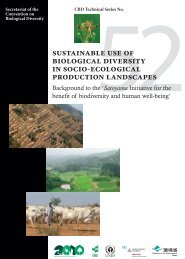INDIAN SCIENCE CONGRESS - India Environment Portal
INDIAN SCIENCE CONGRESS - India Environment Portal
INDIAN SCIENCE CONGRESS - India Environment Portal
Create successful ePaper yourself
Turn your PDF publications into a flip-book with our unique Google optimized e-Paper software.
Section XIV : Plant Sciences 75<br />
Keywords : Floristic diversity, Labpur, Bolpur-Shantiniketan, Sainthia,<br />
Phanersphyte<br />
Study of floristic diversity of Labpur and surrounding other two blocks<br />
Bolpur-Shantiniketan and Sainthia was carried out in 13 selected study sites<br />
having uniform composition. A total number of 438 species of angiosperms were<br />
encountered during the sampling of vegetation. Showing the diversity of flora.<br />
They belonges to 87 families including 78 of dicotyledons and 09 of monocotyledons.<br />
Based on species contributions. Papilionaceae (30), Cyperaceae<br />
(30),Poaceae (25),Asteraceae (24),Solanaceae (20) were found as dominant<br />
families. The phanersphytic and chamaepphytic life form was comparatively<br />
higher in these areas. All specimens are preserved in herbaria of Botany<br />
department of Sambhu Nath College, Labpur.<br />
94. Tree Species Diversity and Dominance of Forest Vegetation in Central<br />
<strong>India</strong><br />
A. S. Thakur 1 and P. K. Khare 2<br />
1 Department of Botany,<br />
Govt. College, Khurai,<br />
Sagar 470117 (M.P.)<br />
2<br />
Department of Botany,<br />
Dr. H. S. Gour Vishwavidyalaya,<br />
Sagar-470003 (M.P.)<br />
Keywords : Species diversity, Richness, Diversity, Forest communities, Sagar District<br />
Species and diversity of tree species were analysed in 10 respresentative<br />
forest sites occurring in Sagar District (Madhya Pradesh). Species richness and<br />
species richness index ranged from 18 to 50 and 1. 120 to 2. 343 respectively.<br />
Shannon-Wiener diversity index ranged between 2. 22-3. 66 and Beta diversity<br />
ranged between 0. 69-1. 83. The values of concentration of dominance were<br />
generally low at all study sites indicating the dominance is shared by more than one<br />
and/or many species. Dominance-diversity curves showed log-normal distribution,<br />
also indicative of shared resources pattern by a number of species and mixed<br />
nature of vegetation.
















